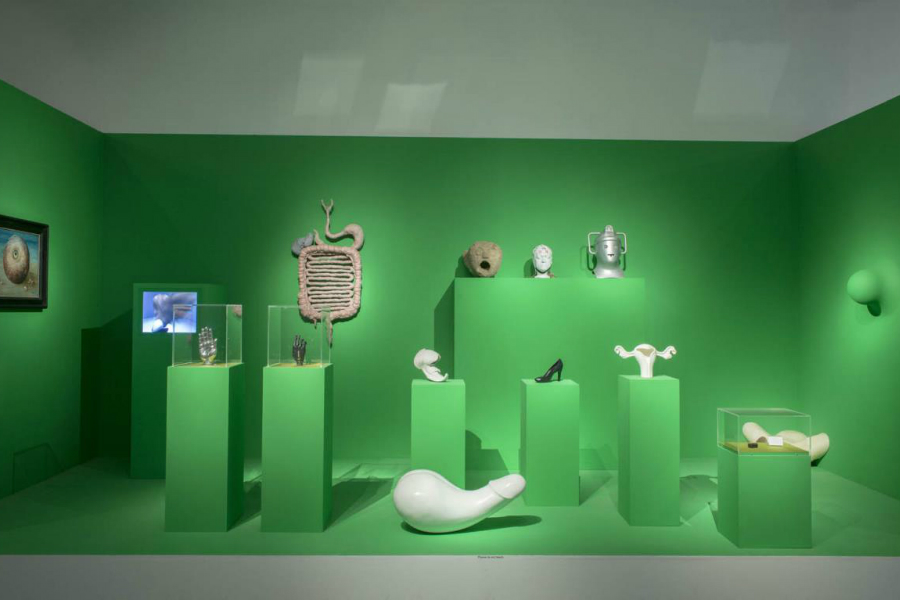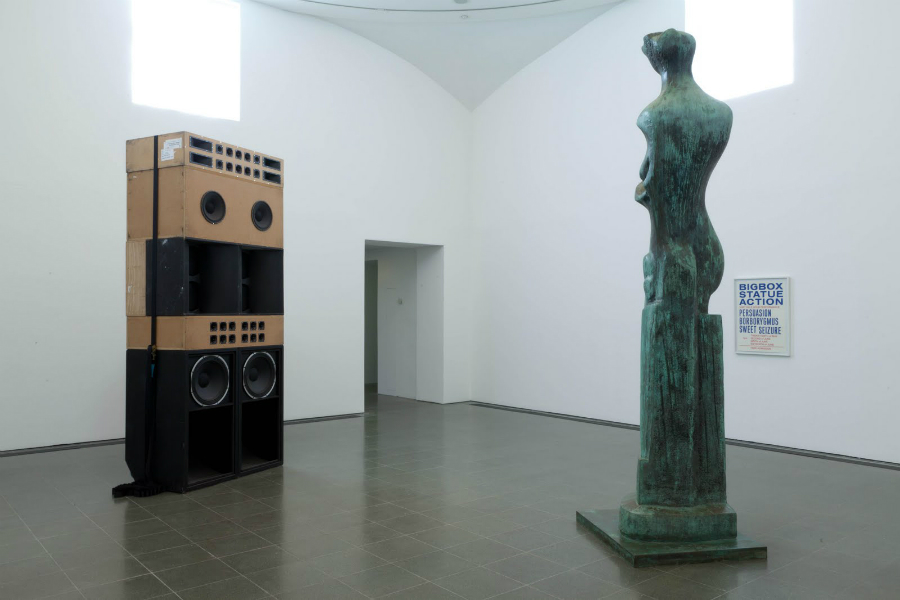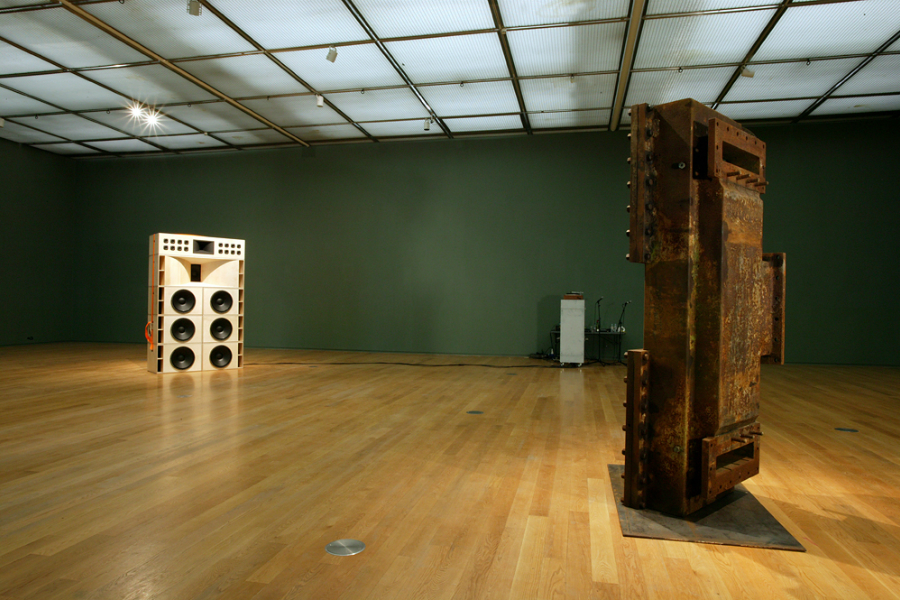Mark Leckey: transformed by the digital realm

Mark Leckey trys to explain the ‘aboriginal shudder’, and the origins of The Universal Addressability of Dumb Things…
The current show-stopping exhibition at the Bluecoat is the first major project in Liverpool for Turner Prize winning artist Mark Leckey. Born in 1964 in Eastham, Ellesmere Port, the artist’s curated exhibition, The Universal Addressability of Dumb Things, is based on ‘how our relationships with artworks and common objects are being transformed through new technologies’. In a talk at the gallery this week, he attempted to explain how the show came into being from a long line of ideas, influences and desires to enter ‘a digital realm’. Here we present a snapshot of Mark’s insights:
“For me to put together a show, it’s essentially now making like a Tumblr … there’s a democracy to curating; you can call it curating or you can call it aggregating, but that’s what everybody does now. They put things together. They gather things, they aggregate things, then they put them together and they publish them, broadcast them. There’s a good joke: there’s a couple at a party, and one says ‘what do you do?’ and the other replies, ‘I curate children’s birthday parties.’ And that’s where curation is.
“I wonder why do you need to transpose images … to a gallery, to the physical world? The question I suppose has an obvious answer; the things … have qualities, a what-ness, they have an aura. To be able to gain access to those things in the flesh is exciting; it is to access their power. But they’re also dumb, in the sense that things here [in the computer] have a life, an anima quality, that those objects don’t. These were the confused thoughts going through my head when I was first asked to do the show.
“This is a piece I made in around 2003 called Big Box Statue Action … at Tate Britain; this is a statue by Jacob Epstein called Jacob and the Angel. I’ve been going to Tate Britiain for a long time, and it’s always there. They’re always shunting it around, they’re never quite sure where to put it. I always found it very alienating … it has this power and bulk and it’s such an obstinate thing… What I ended up finding is that it speaks a language, i.e. of Modernism, that means nothing to me. I can’t connect with that thing [but] I wanted to address [it]. I made a sound system, because I always loved them as objects that made sound, and made a sound that in itself is sculptural.
“There’s a problem I have with real world objects … they’re in a dimension that I no longer feel comfortable with. To be able to address that, I have to find something to be able to mediate between me and that thing, then I can kind of get closer to it … I got plopped in front of a TV from 2 years old; maybe this is the result of being a TV generation child, the real world has maybe lost its glow, its magic … I was trying to communicate with this statue and illicit a response from it … to make it come to life. I found out a lot about this statue from doing this … going from thinking it was inconsequential to thinking it was magnificent and god-like:
“Originally it was meant to be called Romancing the Stone, but I thought that was a little bit too cheesy.
“Out of that came a couple of pieces. I’m always looking for the effect that things have on me, that’s why I make art … why images can do what do they do to me, why sculptures can do what they do. Thinking about things in terms of what idols do, or fetishes, or totems.
“I did this at the Serpentine [Gallery] with Henry Moore, but it didn’t work, it was too skinny. I was relying on the weight of Henry Moore rather than the weight of the sculpture, the name rather than the thing:

“This did work, this was in Manchester, Big Box Industrial Action, and that big piece of scrap is from a Victorian steam engine … it is this amazing object, like a steam-punk-pastiche of Victorian industry:

“I made about four or five of these sound systems, with a plan in mind to bring them together, like a juggernaut of a sound system (which hopefully they will next year). What I like about them is they have this purpose, this use. I had a band called Jack too Jack and we would use the sound systems when we played. The March of the Big White Barbarians [is] a selection of public sculptures in London. After doing the thing with the Epstein [sculpture], I went out actively looking for public sculptures, other monumental sculptures … again, this language feels lost to me … I know what they mean but they seem very distant … they felt neglected, and I wanted to try to sing them back, to reanimate them and make them alive again, because they seemed dead:
“I’m still thinking about idols … I do end up intellectualising them, but I try my best not to … I’m a festishist, I fetishize things, and I’m drawn to these things and I obsess about these things and I need to possess them in some way, because I feel like they are possessing me. I want some kind of reciprocation. This is Jeff Koons’ Rabbit from ’86 … an icon … it’s an idol of consumer capitalism. It’s the ultimate capitalist object … in its absolute flawless perfection, it’s like a thought made real. It’s magic. I wanted it to appear in my flat … obviously I couldnt get the real bunny … so I made it digitally. I want people to believe that it was actually in my room … it’s this thing of getting close to something. The nearest I can get to having a direct experience with something is in this incredibly convoluted way:
“Really that’s where the show comes from. Technology, being seen as an alienating mechanism … it’s not that I don’t believe it but I don’t accept it. What I want to do with the work that I make is to fully embrace it. Not in a kind of Stephen Fry iPhone way, but allow this other nature of technology to become my nature. I want to be a cyborg. I want a total synthesis between me as an organic living thing and stuff that isn’t. If I surrender to it, I think it can take me places… it seems infinitely expansive to me. This is a marvellous time to be alive and making work … because I can have that in my room, and it might be a little bit sad, and a quite geeky piece of work, but there’s something divine about that.
“Mostly where this show came from is a talk I did called Cinema in the Round, which is about how things on screen can generate (not my phrase) an ‘aboriginal shudder’; you can feel it … the volume or mass of the thing’s been captured at that moment and … you experience in this sensual way … [another talk] In the Long Tail … [tried to explain how] in the 20th Century we are all trying to aim for a number one slot, everything’s trying to be number one, a blockbuster or Top of the Pops. Everything is organised to get to that point … it is organised around things being physical (distribution, lorries etc). What you get with the digital, it no longer needs the enormous distribution system … it can cut all of that out and get straight to the consumer. Populating that are niches directed to what you want … I was using this as an extended metaphor for how we are being transformed by the digital realm … it feeds desires but creates them as well. The Long Tail keeps dividing up and things just get weirder and weirder and weirder. Let me show you an example of what I think comes out of The Long Tail:
“This is Wendy Vainity and she makes these really crazy videos. She says she makes them because she’s essentially trying to learn about the software that makes them, 3D modelling and audio programmes and the rest of it. For me … there’s something really visceral about that. It’s kind of ‘phewwww’; it’s that sensation of seeing an unnatural act, like the cat and the jar. This is what I wanted the show to be, this contains everything I love about the world at the moment. She’s a housewife in Melbourne and she can publish herself on YouTube; she uses software for free – she’s a producer, she makes videos and puts them online and gets an audience. I also like that she gets to enact her weirdest desires … it’s about a different kind of physics, being able to manipulate things.
“I guess that’s what I was trying to do with the show; they’re real world objects, they’re fixed and mutable, and beyond that they’re museum pieces. I can’t physically touch them. I wanted this show to be a quite theatrical and rewarding experience, but more that this allows me to get access to objects, and there’s the opportunity to do things with them. Make them become animated … they’re no longer objects that sit there in dumb silence.”
This is an edited transcription of Mark Leckey’s talk at the Bluecoat, 6pm Weds 10th April 2013
Catch The Universal Addressibility of Dumb Things while you can – on at the Bluecoat daily 10am-6pm, until Sun 14th April
All images/video © Mark Leckey. See more here on Mark’s YouTube channel, including the original proposal for the exhibition





